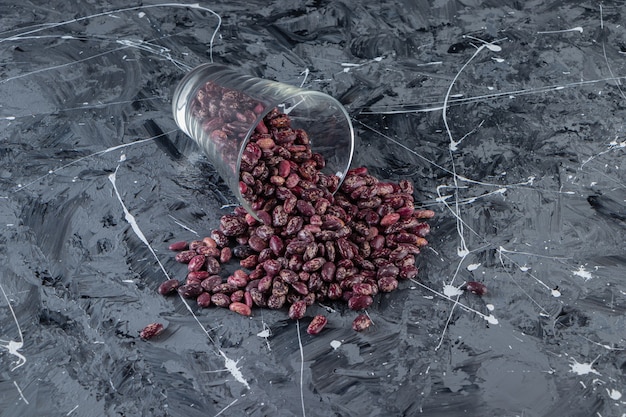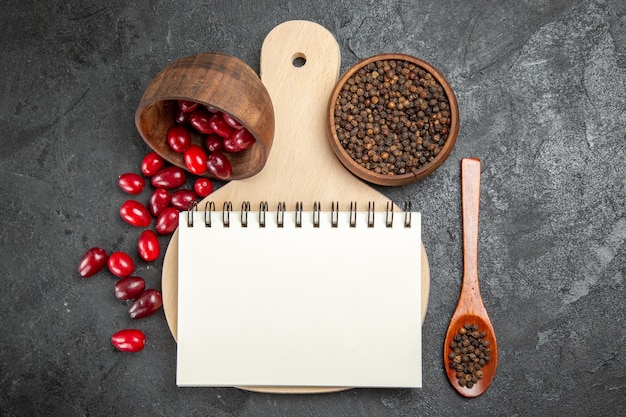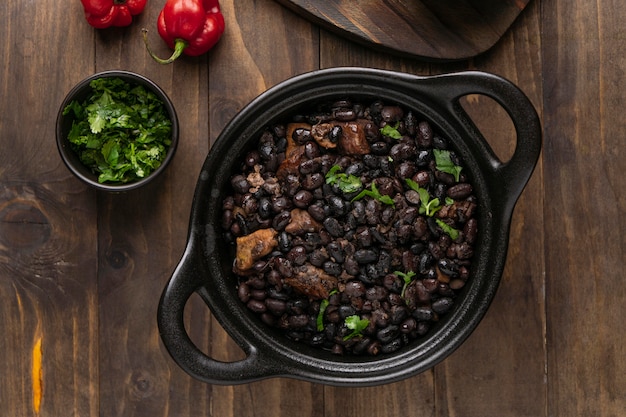(Part 1) Choosing the Right Beans: The Foundation of Flavour

Tips for Picking the Perfect Beans:
- Check the expiry date: This might seem obvious, but you'd be surprised how many people don't pay attention to it. fresh beans cook up better, with a more vibrant flavour.
- Avoid beans with any kind of discoloration: It's a sign that they've gone bad. Look for beans that are uniformly coloured, with no brown spots or other signs of deterioration.
- Give them a good sniff: They should have a neutral aroma, not a strong or pungent smell. If they smell off, it's best to avoid them.
(Part 2) Prepping Your Beans: The Secret to a Smooth Texture

The Power of Soaking:
- Soaking makes them cook faster: Who doesn't love a quick meal? Soaking softens the beans, allowing them to cook faster and more evenly.
- It helps remove some of the indigestible sugars: This makes your beans easier to digest and can prevent any unwanted bloating or gas.
- It gives them a smoother texture: So, no mushy beans! The soaking process helps break down some of the starches, resulting in beans with a smoother and creamier texture.
Here's what I do: I usually soak my beans overnight in plenty of cold water. Make sure they're covered by at least 2 inches of water. In the morning, I drain them and give them a good rinse. Now they’re ready for the main event!
(Part 3) The Art of the Broth: Flavouring Your Beans

The Broth Options:
- chicken broth: A classic choice for a rich, umami flavour. The chicken broth adds a savoury base, enhancing the overall taste of the beans.
- vegetable broth: Perfect for a vegetarian or vegan option. It provides a lighter flavour profile, but still delivers a great depth of flavour.
- homemade broth: The ultimate flavour bomb. You can use leftover chicken bones or vegetable scraps to make your own broth, adding layers of flavour you wouldn't get from store-bought broth. Homemade broth is packed with natural flavour and depth.
- Water: If you’re feeling basic, plain water works too, just add a good pinch of salt. It's a simple option for those who prefer a less intense flavour.
But don’t stop there! Now’s the time to add your personal touch. It's like seasoning a blank canvas, you can go wild with herbs, spices, and vegetables.
Flavour Boosters:
- Celery, onions, and garlic: A classic flavour combo for a base. They provide a foundation of sweetness and aromatic depth.
- Bay leaves: Add a touch of earthy, aromatic magic. They lend a subtle but complex flavour.
- Thyme and oregano: Bring in a herbaceous touch. They add a fresh and slightly peppery flavour.
- Smoked paprika: Adds a bit of depth and smokiness. It infuses a rich, smoky flavour, adding complexity to the dish.
- Hot sauce: For a kick of heat! It brings a touch of heat and a spicy tang to the beans.
(Part 4) The Big Cook: Bringing Your Beans to Life
Alright, time to get cooking! Here’s where the magic happens. Remember to use a large pot, as the beans will expand as they cook. You’ll want enough space for them to move around freely and cook evenly.cooking time:
- Bring your broth to a boil: Once it’s bubbling, add your beans and reduce the heat to a simmer. This allows the beans to gently cook in the flavorful broth.
- Simmer for 1-2 hours: This gives the beans time to soften and absorb the flavour from the broth. This slow cooking process develops the rich texture and flavour of the beans.
- Stir occasionally: You want to make sure the beans don't stick to the bottom of the pot. This ensures even cooking and prevents the beans from burning.
- Check for doneness: Once the beans are tender and easily mashed with a fork, they're ready. This is a sure sign that the beans are cooked through and ready to be enjoyed.
Now, I know you might be tempted to just throw your rice in the same pot and call it a day. But, I'm going to stop you right there. There’s a better way to do it. We’ll get to that in a bit.
(Part 5) The Importance of Seasoning: Elevating the Flavour
The beans are cooked, but we’re not finished yet. It’s time to take your red beans and rice from “good” to “amazing.” Seasoning is everything!The Salt and Pepper Duo:
- Don’t be afraid of salt: Beans need a good pinch of salt to enhance their flavour. Salt brings out the natural flavours of the beans, making them taste richer and more complex.
- Freshly ground black pepper: Adds a bit of spice and depth. Black pepper provides a warm, slightly pungent flavour that adds a nice contrast to the sweetness of the beans.
Beyond the Basics:
- Hot sauce: A personal favourite. I add a generous splash to my beans for a kick. Hot sauce adds a spicy tang and heat, bringing a dynamic flavour to the beans.
- Vinegar: A dash of apple cider vinegar or white vinegar adds a bright, tangy flavour. It helps balance the richness of the beans, adding a refreshing note.
- Sugar: A touch of sweetness balances the savoury notes. Just a pinch of sugar can help bring out the depth of flavour in the beans and create a more harmonious taste.
- Garlic powder: For a boost of flavour. It adds a pungent aroma and a subtle garlic flavour to the beans.
Now, I know this might sound like a lot, but the key is to taste as you go and adjust the seasoning to your liking. Every batch is unique!
(Part 6) The perfect rice Companion: A Textural Contrast
Remember how I said there’s a better way to cook your rice than just throwing it in with the beans? Let’s talk about that. The ideal red beans and rice experience requires a separate pot of rice cooked to perfection.Rice Tips:
- Use long-grain white rice: It holds its shape well and is perfect for soaking up the beans and gravy. long-grain rice provides a firm texture that doesn't turn mushy when combined with the beans and broth.
- Rinse the rice before cooking: This removes excess starch and prevents it from getting clumpy. Rinsing helps the rice cook more evenly and prevents it from becoming sticky.
- Use a rice cooker: A rice cooker is a lifesaver for consistently perfect rice. It takes the guesswork out of cooking rice, ensuring that it comes out fluffy and perfectly cooked every time.
- Follow the instructions on the package: For the perfect rice-to-water ratio. The instructions are a reliable guide to ensure the right consistency and texture for your rice.
Remember to cook the rice separately from the beans so that it doesn't get mushy. You want it to have a nice texture and be fluffy.
(Part 7) Bringing it All Together: The Grand Finale
Now for the moment you’ve been waiting for! It’s time to combine the magic of red beans and rice.The Assembly:
- Serve the beans on top of the rice: This way, the rice acts as a base and absorbs the delicious bean broth. It creates a visually appealing dish and allows the rice to soak up the rich flavours of the beans and broth.
- Spoon some of the bean broth over the rice: This adds another layer of flavour and makes it even more delicious. The broth adds a depth of flavour and moisture to the rice, enhancing the overall taste.
- Add your favourite toppings: This is where you get creative. I love a good sprinkle of chopped green onions, some diced tomatoes, and a dollop of sour cream. Experiment with different toppings to create your perfect combination.
And there you have it, the perfect plate of red beans and rice. It’s simple, yet incredibly satisfying.
(Part 8) Red Beans and Rice: Beyond the Basics
Now, I’ve given you the foundation for the ultimate red beans and rice, but don’t think you have to stick to the script. This is your chance to get creative and make it your own. Here are some ideas to play around with:Variations:
- Spice it up: Add some cayenne pepper, jalape??o peppers, or scotch bonnet peppers for a real kick. These spices add a burst of heat and flavour, perfect for those who enjoy a little spice.
- Get smoky: Use smoked sausage, bacon, or ham to add a smoky depth. The smokiness adds a rich and complex flavour, elevating the dish to a whole new level.
- Add some greens: Sautéed collard greens or spinach are a delicious addition. They add a healthy dose of nutrients and a nice textural contrast to the beans and rice.
- Go vegetarian: Substitute the sausage or ham with vegetarian alternatives like tempeh or mushrooms. This allows you to enjoy the dish without any animal products.
The possibilities are endless. Experiment, have fun, and discover your own perfect combination!
(Part 9) Red Beans and Rice: A culinary journey
Red beans and rice is more than just a meal; it's a journey through flavour, history, and culture. It’s a dish that connects us to our roots, our families, and our traditions. It’s a dish that can transport you back in time and remind you of the simple pleasures in life.The History:
This dish has a rich history, originating in West Africa and brought to the Americas through the transatlantic slave trade. It was a staple food for African Americans who adapted the dish using readily available ingredients and methods. It has evolved and been passed down through generations, becoming a beloved dish across the Southern United States.
The Cultural Significance:
Red beans and rice are deeply ingrained in the culture of Louisiana and the Southern United States. It’s a dish that’s served at festivals, family gatherings, and everyday meals. It’s a dish that brings people together and fosters a sense of belonging. It's also a dish that's associated with Monday, often referred to as "Red Beans and Rice Monday" in Louisiana, reflecting its historical significance as a day for communal gatherings.
The Personal Connection:
For me, red beans and rice is a dish that evokes memories of my childhood. It reminds me of my grandmother’s kitchen, filled with the aroma of simmering beans and the warmth of family. It’s a dish that comforts me and makes me feel connected to my roots.
FAQs
| Question | Answer |
|---|---|
| How long can I store cooked red beans and rice? | You can store cooked red beans and rice in the refrigerator for up to 3-4 days. Just make sure you store them in an airtight container. This will help prevent them from drying out and absorbing other flavours in the fridge. |
| Can I freeze cooked red beans and rice? | Yes, you can freeze cooked red beans and rice for up to 3 months. To freeze them, let them cool completely and then transfer them to freezer-safe bags or containers. It's best to freeze the beans and rice separately, as the rice can become mushy when thawed. |
| What can I do with leftover red beans? | Leftover red beans are a great addition to salads, burritos, or tacos. You can also use them to make a delicious soup or stew. They can add a hearty texture and flavour to many dishes. |
| Can I make red beans and rice in a slow cooker? | Absolutely! A slow cooker is a great way to cook red beans and rice. Just follow the same instructions as you would for stovetop cooking, but cook them on low for 6-8 hours or on high for 3-4 hours. The slow cooker allows the beans to absorb more flavour and develop a rich, creamy texture. |
| What is the best way to serve red beans and rice? | The best way to serve red beans and rice is with a dollop of sour cream or yogurt, a sprinkle of chopped green onions, and some hot sauce. You can also add other toppings like diced tomatoes, sliced avocado, or cooked sausage. Experiment and find your favourite combination! |
Everyone is watching

Prime Rib Roast Cooking Time Chart: Per Pound Guide
Cooking TipsPrime rib roast. Just the name conjures images of lavish dinners, crackling fires, and hearty laughter. It’s ...

How Long to Bake Potatoes in the Oven (Perfect Every Time)
Cooking TipsBaked potatoes are a staple in my kitchen. They're incredibly versatile, delicious, and surprisingly easy to m...

Perfect Rice Every Time: The Ultimate Guide to Cooking Rice
Cooking TipsAs a self-proclaimed foodie, I've always been a bit obsessed with rice. It's the foundation of countless cuisi...

The Ultimate Guide to Cooking Asparagus: Tips, Techniques, and Recipes
Cooking TipsAsparagus. The mere mention of this spring delicacy conjures up images of vibrant green spears, crisp and burs...

Ultimate Guide to Cooking the Perfect Thanksgiving Turkey
Cooking TipsThanksgiving. Just the word conjures up images of overflowing tables laden with delicious food, the scent of r...
